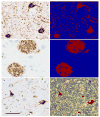The limbic and neocortical contribution of α-synuclein, tau, and amyloid β to disease duration in dementia with Lewy bodies
- PMID: 29100980
- PMCID: PMC5899889
- DOI: 10.1016/j.jalz.2017.09.014
The limbic and neocortical contribution of α-synuclein, tau, and amyloid β to disease duration in dementia with Lewy bodies
Abstract
Introduction: We sought to assess the individual and combined contribution of limbic and neocortical α-synuclein, tau, and amyloid β (Aβ) to duration of illness in dementia with Lewy bodies (DLB).
Methods: Quantitative digital pathology of limbic and neocortical α-synuclein, tau, and Aβ was assessed in 49 patients with clinically probable DLB. Regression modeling examined the unique and shared contribution of each pathology to the variance of illness duration.
Results: Patients with diffuse Lewy body disease had more severe pathology of each type and a shorter duration of illness than individuals with transitional Lewy body disease. The three pathologies accounted for 25% of the total variance of duration of illness, with 19% accounted for by α-synuclein alone or in combination with tau and Aβ. When the diffuse Lewy body disease group was examined separately, α-synuclein deposition significantly exceeded that of tau and Aβ. In this model, 20% of 24% total variance in the model for duration of illness was accounted for independently by α-synuclein.
Discussion: In DLB, α-synuclein is an important predictor of disease duration, both independently and synergistically with tau and Aβ.
Keywords: Alzheimer's disease; Commonality analysis; Lewy body; Parkinsonism; Pathology; REM sleep behavior disorder.
Copyright © 2017 the Alzheimer's Association. Published by Elsevier Inc. All rights reserved.
Conflict of interest statement
Drs. Ferman, Aoki, Kantarci, Van Gerpen, J. Graff-Radford, Pedraza, Murray and Dickson report no conflicts of interest.
Dr. Boeve has served as an investigator for clinical trials sponsored by GE Healthcare, FORUM Pharmaceuticals and C2N Diagnostics. He receives royalties from the publication of a book entitled
Dr. N. Graff-Radford serves on a scientific advisory board for Codman; serves on the editorial boards of The Neurologist and Alzheimer Disease and Therapy; has received publishing royalties from UpToDate, Inc.; and receives research support from Biogen, Lilly and Axovant. He has consulted for Cytox.
Dr. Wszolek is supported by The Cecilia and Dan Carmichael Family Foundation and James C. and Sarah K. Kennedy Fund, and The Sol Goldman Charitable Trust.
Dr. Uitti serves as an Associate Editor for
Figures




Similar articles
-
Significant Overlap of α-Synuclein, Amyloid-β, and Phospho-Tau Pathologies in Neuropathological Diagnosis of Lewy-related Pathology: Evidence from China Human Brain Bank.J Alzheimers Dis. 2021;80(1):447-458. doi: 10.3233/JAD-201548. J Alzheimers Dis. 2021. PMID: 33554920
-
Relationship of phosphorylated alpha-synuclein and tau accumulation to Abeta deposition in the cerebral cortex of dementia with Lewy bodies.Exp Neurol. 2008 Apr;210(2):409-20. doi: 10.1016/j.expneurol.2007.11.019. Epub 2007 Dec 3. Exp Neurol. 2008. PMID: 18164295
-
Confluence of α-synuclein, tau, and β-amyloid pathologies in dementia with Lewy bodies.J Neuropathol Exp Neurol. 2013 Dec;72(12):1203-12. doi: 10.1097/NEN.0000000000000018. J Neuropathol Exp Neurol. 2013. PMID: 24226269
-
The Mechanisms of the Roles of α-Synuclein, Amyloid-β, and Tau Protein in the Lewy Body Diseases: Pathogenesis, Early Detection, and Therapeutics.Int J Mol Sci. 2023 Jun 17;24(12):10215. doi: 10.3390/ijms241210215. Int J Mol Sci. 2023. PMID: 37373401 Free PMC article. Review.
-
Lewy body pathology in Alzheimer's disease.J Mol Neurosci. 2001 Oct;17(2):225-32. doi: 10.1385/jmn:17:2:225. J Mol Neurosci. 2001. PMID: 11816795 Review.
Cited by
-
Association of Longitudinal β-Amyloid Accumulation Determined by Positron Emission Tomography With Clinical and Cognitive Decline in Adults With Probable Lewy Body Dementia.JAMA Netw Open. 2019 Dec 2;2(12):e1916439. doi: 10.1001/jamanetworkopen.2019.16439. JAMA Netw Open. 2019. PMID: 31790563 Free PMC article.
-
Severe hyposmia distinguishes neuropathologically confirmed dementia with Lewy bodies from Alzheimer's disease dementia.PLoS One. 2020 Apr 22;15(4):e0231720. doi: 10.1371/journal.pone.0231720. eCollection 2020. PLoS One. 2020. PMID: 32320406 Free PMC article.
-
A how-to guide for a precision medicine approach to the diagnosis and treatment of Alzheimer's disease.Front Aging Neurosci. 2023 Aug 17;15:1213968. doi: 10.3389/fnagi.2023.1213968. eCollection 2023. Front Aging Neurosci. 2023. PMID: 37662550 Free PMC article. Review.
-
Vascular Lesions, APOE ε4, and Tau Pathology in Alzheimer Disease.J Neuropathol Exp Neurol. 2021 Feb 22;80(3):240-246. doi: 10.1093/jnen/nlaa160. J Neuropathol Exp Neurol. 2021. PMID: 33617650 Free PMC article.
-
Alzheimer's Disease Neuropathological Comorbidities are Common in the Younger-Old.J Alzheimers Dis. 2021;79(1):389-400. doi: 10.3233/JAD-201213. J Alzheimers Dis. 2021. PMID: 33285640 Free PMC article.
References
-
- Marui W, Iseki E, Kato M, Akatsu H, Kosaka K. Pathological entity of dementia with Lewy bodies and its differentiation from Alzheimer’s disease. Acta Neuropathol. 2004;108:121–8. - PubMed
-
- Fujishiro H, Iseki E, Higashi S, Kasanuki K, Murayama N, Togo T, et al. Distribution of cerebral amyloid deposition and its relevance to clinical phenotype in Lewy body dementia. Neurosci Lett. 2010;486:19–23. - PubMed
-
- Hansen LA, Masliah E, Galasko D, Terry RD. Plaque-only Alzheimer disease is usually the lewy body variant, and vice versa. J Neuropathol Exp Neurol. 1993;52:648–54. - PubMed
-
- Deramecourt V, Bombois S, Maurage CA, Ghestem A, Drobecq H, Vanmechelen E, et al. Biochemical staging of synucleinopathy and amyloid deposition in dementia with Lewy bodies. J Neuropathol Exp Neurol. 2006;65:278–88. - PubMed
-
- Walker L, McAleese KE, Thomas AJ, Johnson M, Martin-Ruiz C, Parker C, et al. Neuropathologically mixed Alzheimer’s and Lewy body disease: burden of pathological protein aggregates differs between clinical phenotypes. Acta Neuropathol. 2015;129:729–48. - PubMed
Publication types
MeSH terms
Substances
Grants and funding
LinkOut - more resources
Full Text Sources
Other Literature Sources
Medical
Miscellaneous

